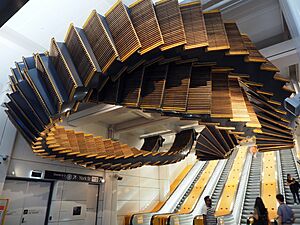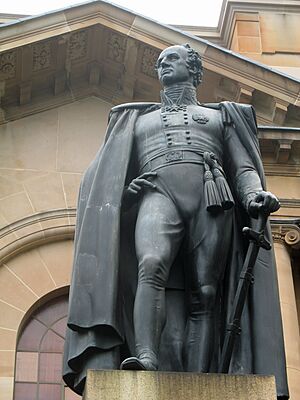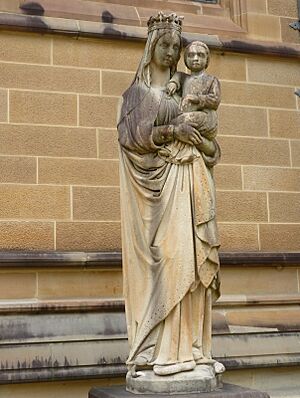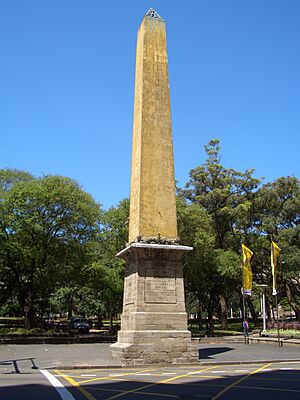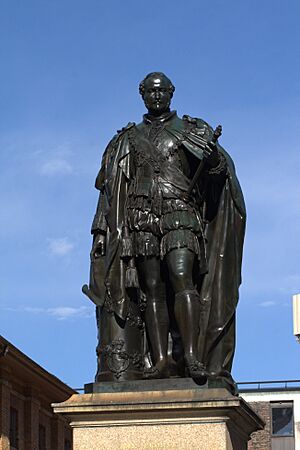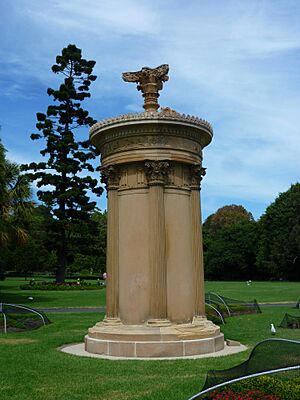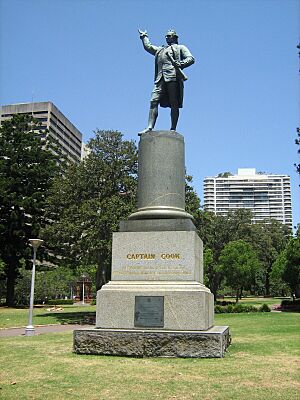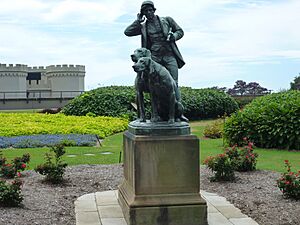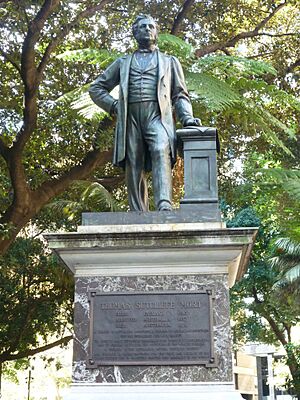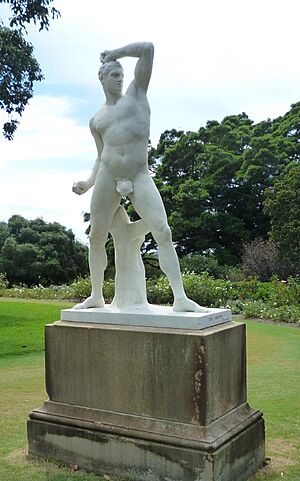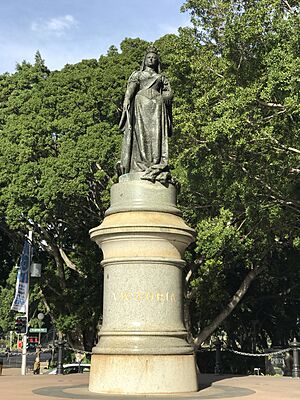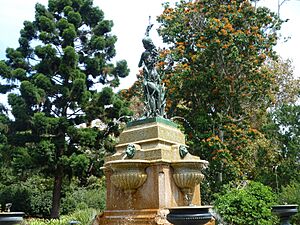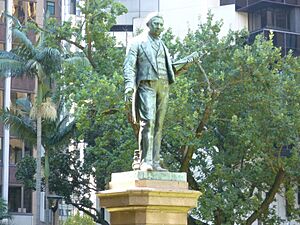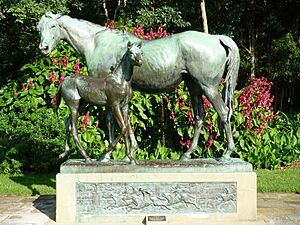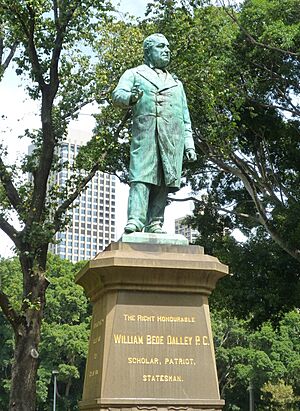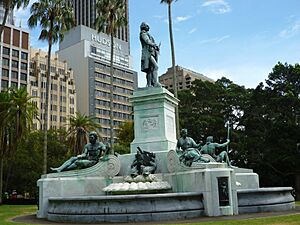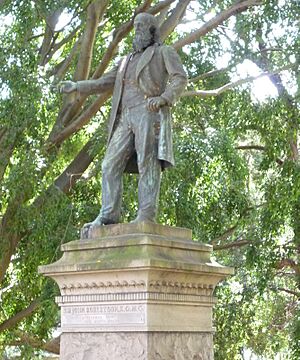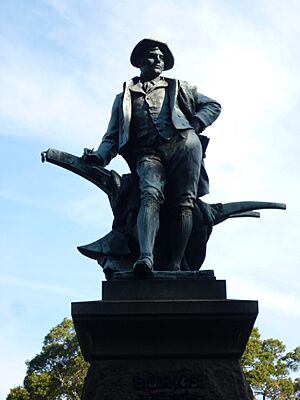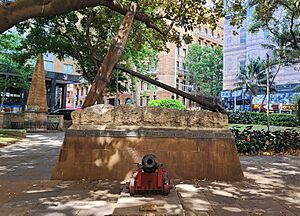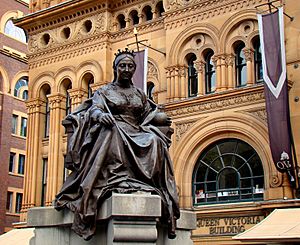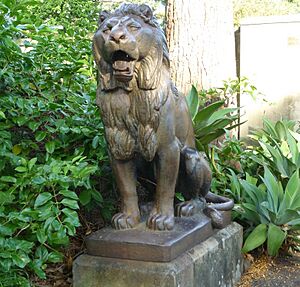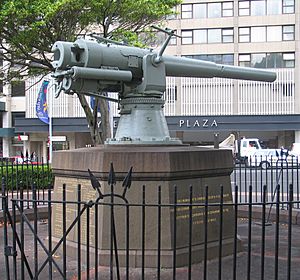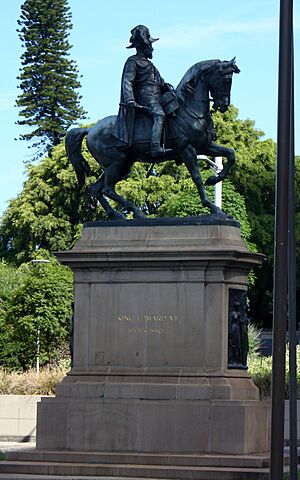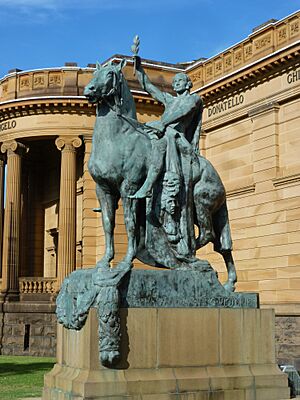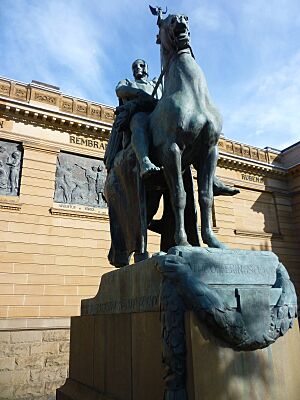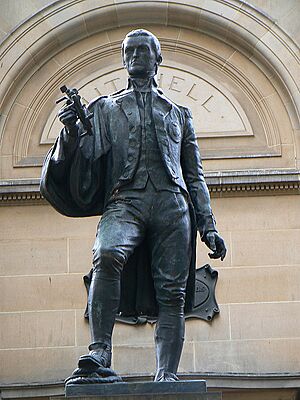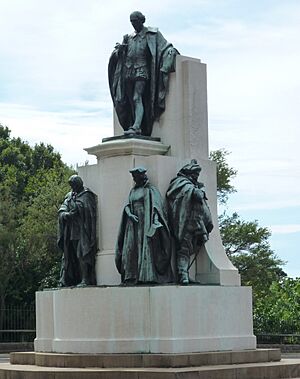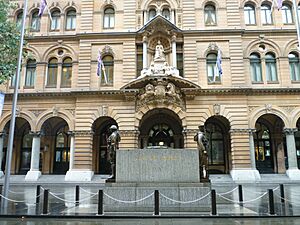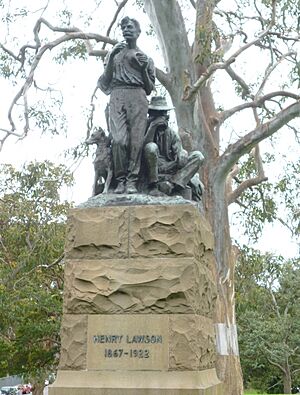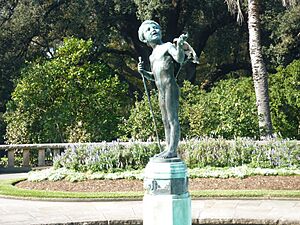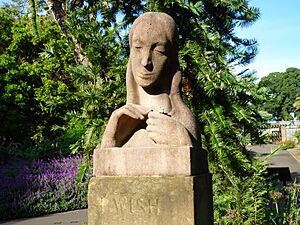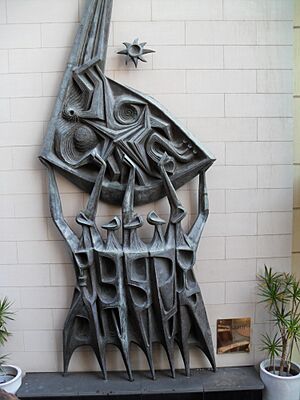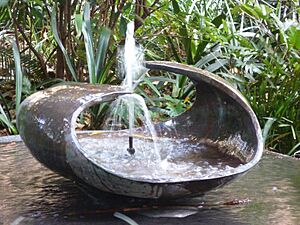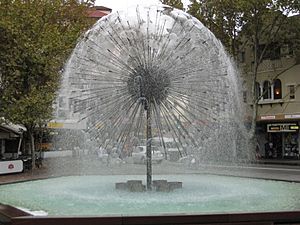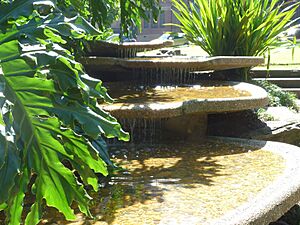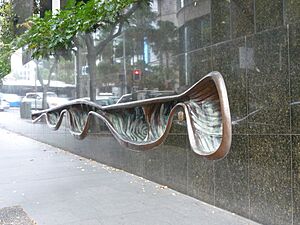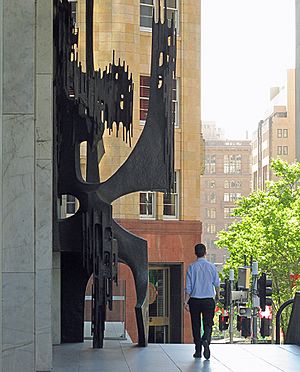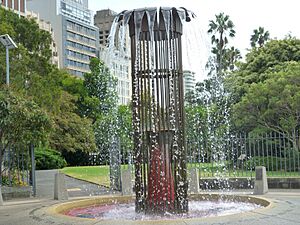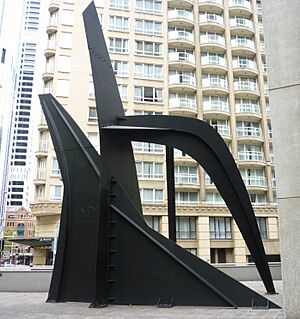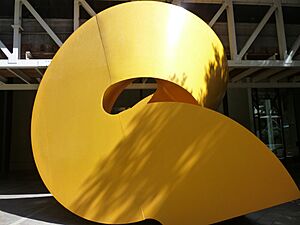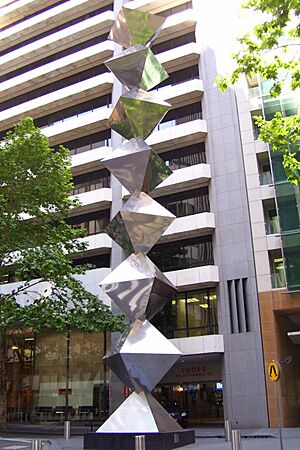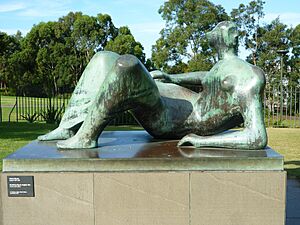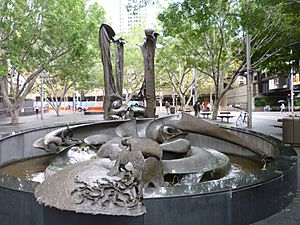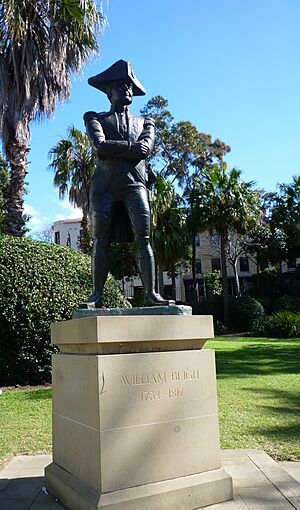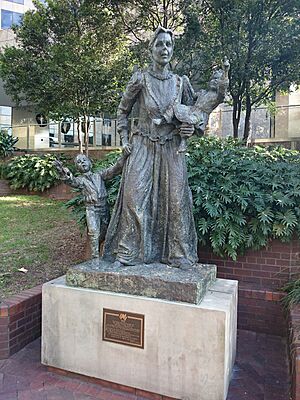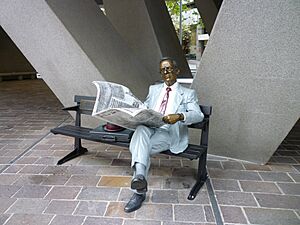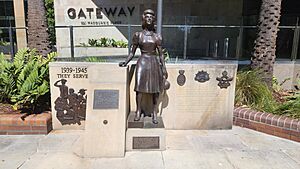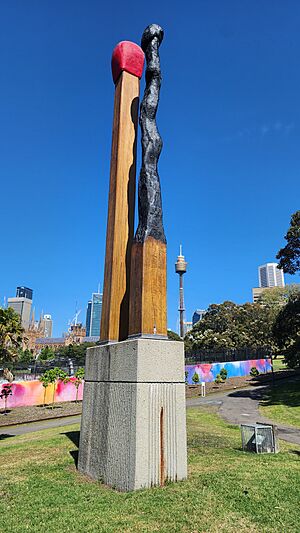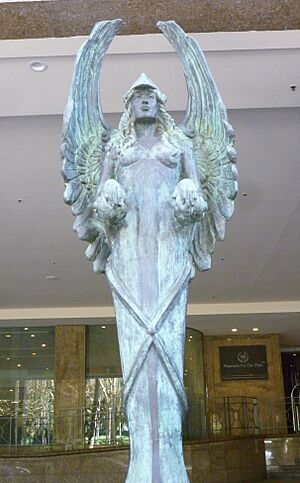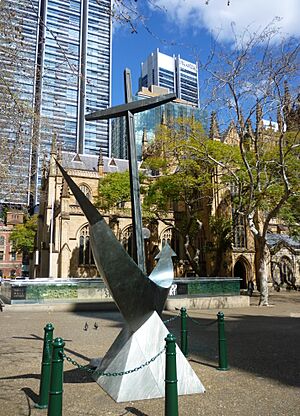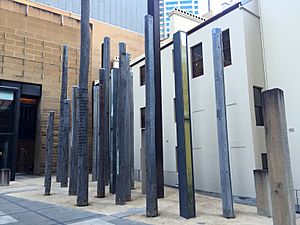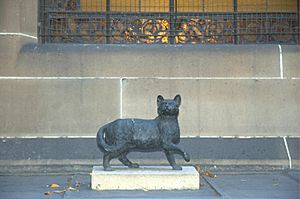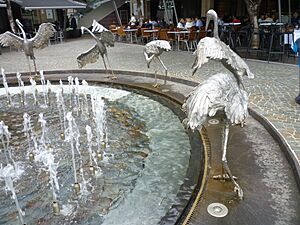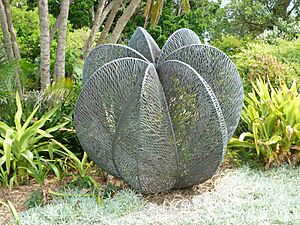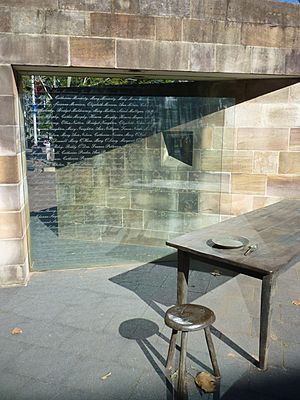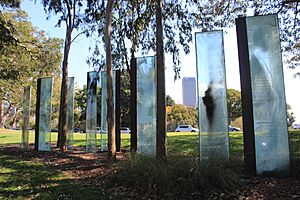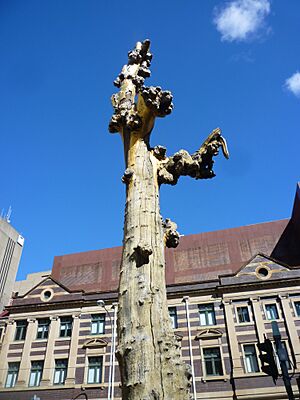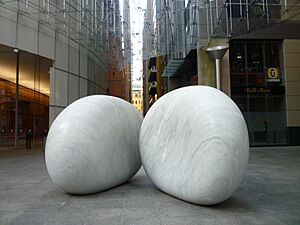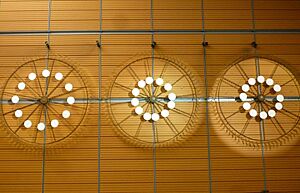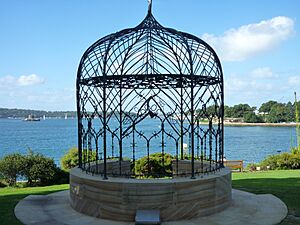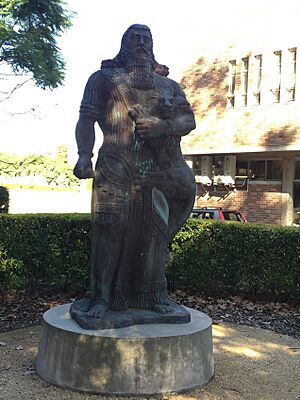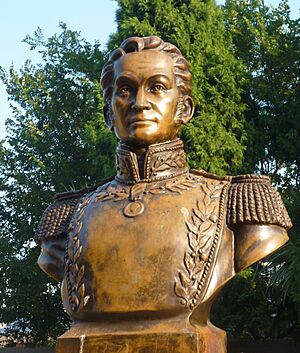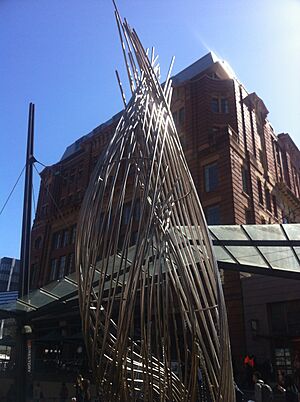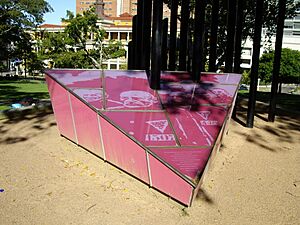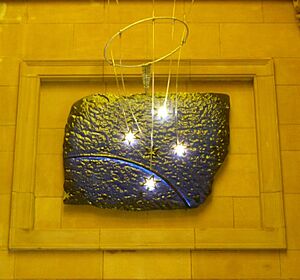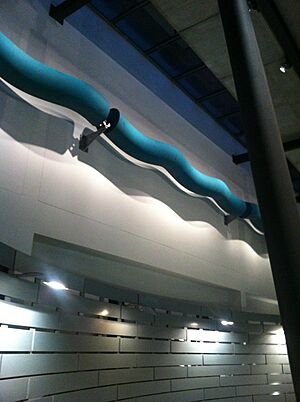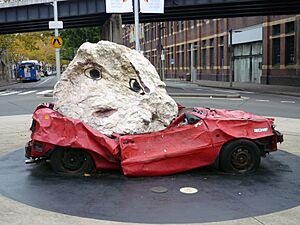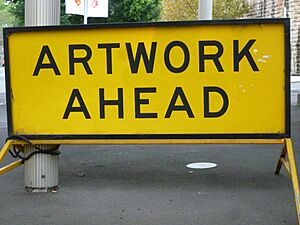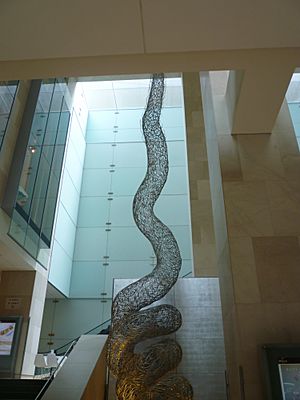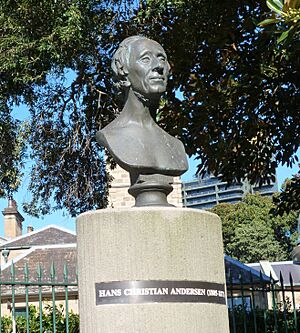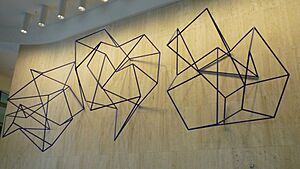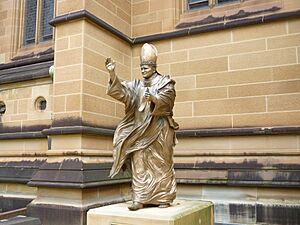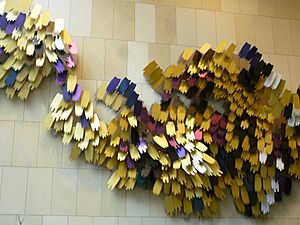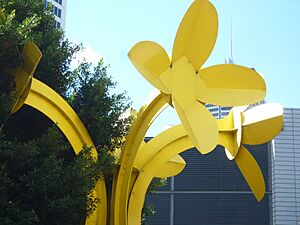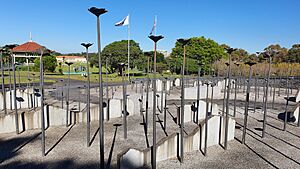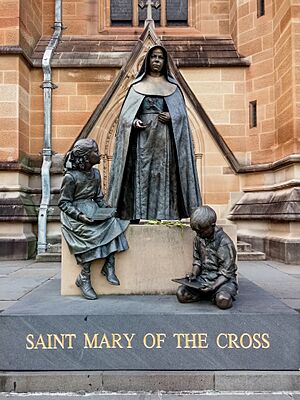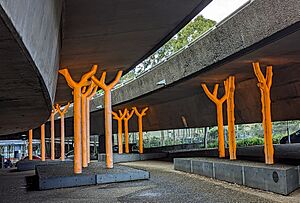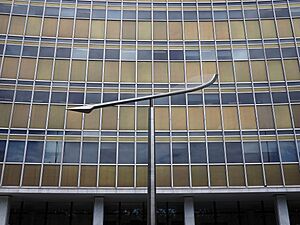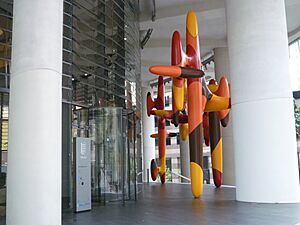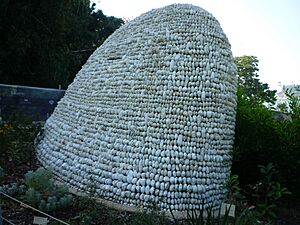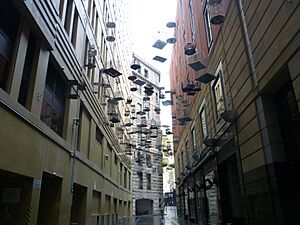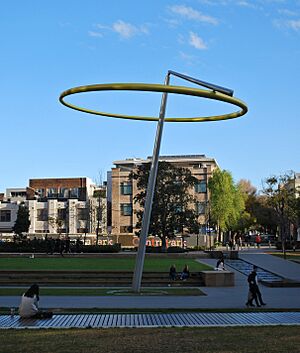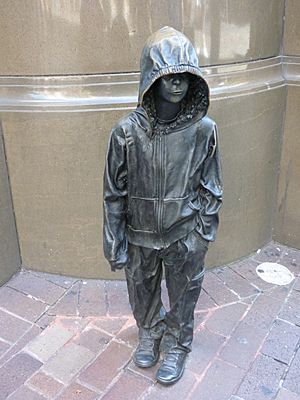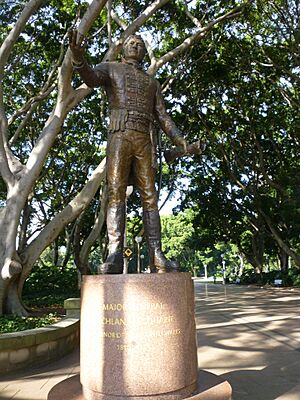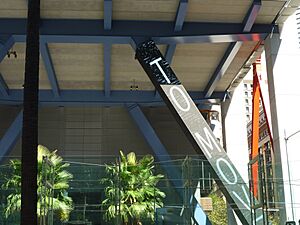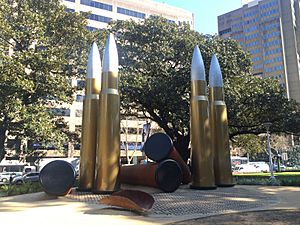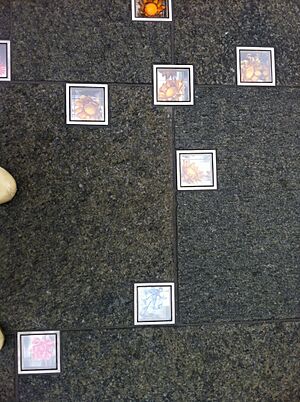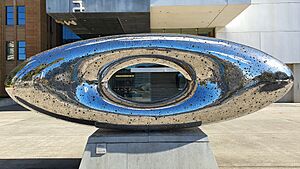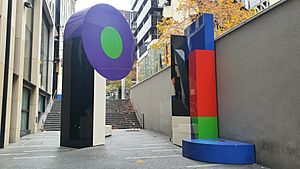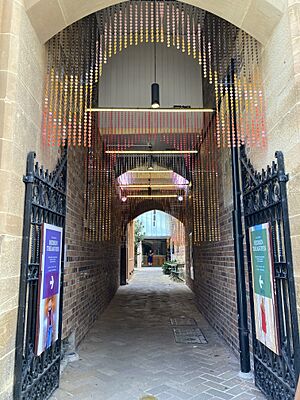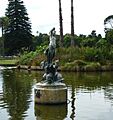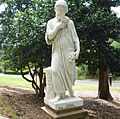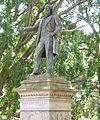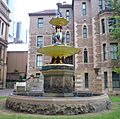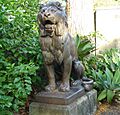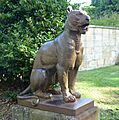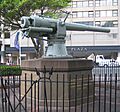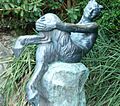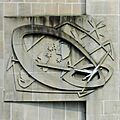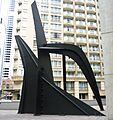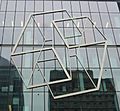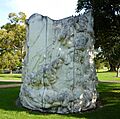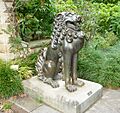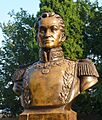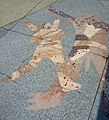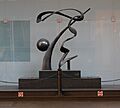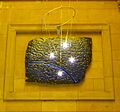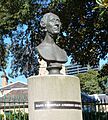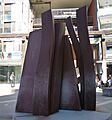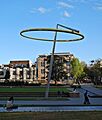List of public art in the City of Sydney facts for kids
Public art in the City of Sydney is like an open-air museum! All around Sydney, Australia, you can find amazing artworks. These pieces are not just in galleries; they are in parks, on buildings, and even in train stations. Some art is just for beauty, while other pieces tell a story or remember important events.
Artists from all over the world have created sculptures for Sydney. You can see works by Australian artists like Bronwyn Oliver and Bertram Mackennal. There are also pieces by famous artists from other countries, such as Henry Moore from Britain and Alexander Calder from America.
Artists use many different materials to create public art. You might see sculptures made from classic materials like marble and bronze. But there are also modern works made from steel, concrete, and even aluminium. Some newer artworks can move, make music, or make you think in new ways!
Many sculptures in Sydney celebrate important people or ideas. Some fountains are memorials, like the Levy Drinking Fountain. Other statues honor famous people, such as writers, artists, or soldiers. There are also artworks that celebrate nature, like trees and animals. You can find sculptures of local plants, dancing birds, and even famous pets!
Contents
What is Public Art?
Public art is any artwork displayed in a public space. It's there for everyone to enjoy, not just people who visit a museum. These artworks can be sculptures, murals, or even special designs in the pavement. They help make the city more interesting and beautiful.
Why is Public Art Important?
Public art helps tell the story of a city. It can show what people value and remember important moments. It also makes public spaces more fun and inviting. Sometimes, public art even helps us learn about history or nature.
Art Through the Years: A Timeline
Sydney's public art has changed a lot over time. In the past, many statues honored kings, generals, or important leaders. They often stood on tall pedestals to show power. Today, public art is more about making places come alive. It encourages people to interact, discuss, and think about their surroundings.
Art from the 1800s
In the 1800s, many art projects were ordered by the church, the government, or wealthy individuals. There was a strong connection between Australian and British artists during this time.
| Year | Image | Title | Artist/s | Location | What it's about |
|---|---|---|---|---|---|
| 1842 | Governor Bourke | Edward Hodges Baily | Outside the State Library of New South Wales | This statue honors Governor Richard Bourke. It was unveiled with a big parade in 1842. | |
| 1850 | Our Lady and the child Jesus | Dom Eugene Gourbeillon (OSB) | St Mary's Cathedral | The artist was a priest in Sydney. The statue was replaced in 2008. | |
| 1857 | Hyde Park Obelisk | Hyde Park | This tall, 22-meter sandstone tower was first a sewer vent. It looks like Cleopatra's Needle in London. | ||
| 1866 | Albert the Good | William Theed | Macquarie Street | A statue of Prince Albert, Queen Victoria's husband. He wears fancy robes and holds a baton. | |
| 1870 | Choragic Monument | Walter McGill | Royal Botanic Garden | This is a smaller copy of an ancient Greek monument. It was moved to the Botanic Garden in 1943. | |
| 1878 | Captain Cook | Thomas Woolner | Hyde Park South | A monument to the famous explorer James Cook. The artist wanted to show Cook full of wonder at discovering a new land. | |
| 1879 | Huntsman and Dogs | Henri Alfred Jacquemart | Royal Botanic Garden | This is one of two copies of an original sculpture. They were made to look like bronze. | |
| 1883 | Thomas Sutcliffe Mort | Pierce Connolly | Macquarie Place | A monument to Thomas Sutcliffe Mort, an important Australian businessman. | |
| 1887 | The Boxers | Charles Francis Summers (Copy of a work by Antonio Canova) | Royal Botanic Garden | This sculpture shows two famous boxers from ancient Greece. It's a copy of a work by Antonio Canova. | |
| 1888 | Victoria | Joseph Edgar Boehm | Queen's Square | Unveiled in 1888, this statue shows Queen Victoria wearing her crown and holding royal symbols. | |
| 1889 | Levy Drinking Fountain | Charles Bell Birch | Royal Botanic Garden | This beautiful fountain was a gift from the Levy family. It features a young girl with reeds, herons, and frogs. | |
| 1890 | John Dunmore Lang | Giovanni Fontana | Wynyard Park | A bronze memorial to John Dunmore Lang, who founded the Presbyterian Church in Australia. | |
| 1891 | Mare and Foal | Arthur le Duc | Royal Botanic Garden | This sculpture of a horse and her foal was bought by the Art Gallery of New South Wales and given to the Garden. | |
| 1897 | William Bede Dalley | James White | Hyde Park | This bronze statue honors William Bede Dalley. Many people attended its unveiling. | |
| 1897 | The Governor Phillip Fountain and statue | Achille Simonetti | Royal Botanic Garden | A statue of Arthur Phillip, the first governor of New South Wales. It stands on a marble column with other figures. |
Art from the 1900s
The 1900s brought new ideas to sculpture. Artists started to challenge old traditions, leading to more modern and abstract art.
| Year | Image | Title | Artist/s | Location | What it's about |
|---|---|---|---|---|---|
| 1904 | John Robertson | designed by John Horbury Hunt, executed by James White | The Domain | This bronze statue remembers John Robertson, who was Premier of New South Wales five times. | |
| 1905 | Robert Burns | Frederick Pomeroy | The Domain | A monument to the famous Scottish poet Robert Burns. Scottish groups helped raise money for it. | |
| 1905 | Sirius Anchor | Unknown | Macquarie Place Park | This is a real anchor from the Sirius, the main ship of the First Fleet. It's an old object that also works as art. | |
| 1908 | Statue of Queen Victoria | John Hughes | Queen Victoria Building | This statue was originally in Ireland. It was moved to Sydney and unveiled by Queen Elizabeth II in 1987. | |
| 1912 | Lion and Lioness | Royal Botanic Garden, outside Lion Gate Lodge | A pair of bronze lions given to the Botanic Garden in 1912. They have been popular with children for many years. | ||
| 1919 | HMAS Sydney I - SMS Emden Memorial | Hyde Park | This is a gun from a German warship, the SMS Emden. It's a war memorial and a trophy given to Sydney because the Australian ship HMAS Sydney I sank the Emden. | ||
| 1922 | Edward VII | Thomas Brock | Corner of Macquarie and Bridge Streets | A bronze statue of King Edward VII on horseback. Money for it came from public donations and the government. | |
| 1923 | The Offerings of Peace | Gilbert Bayes | Art Gallery of New South Wales | This sculpture is about peace and the arts. It has a message on its base: "The Real and Lasting Victories Are those of Peace and Not of War." | |
| 1923 | The Offerings of War | Gilbert Bayes | Art Gallery of New South Wales | This artwork is a companion to Offerings of Peace. It shows a rider with swords and broken spears. | |
| 1925 | Matthew Flinders | William Robert Colton | Macquarie Street, outside the Mitchell Library | A statue of Matthew Flinders, the navigator who mapped Australia's coast. His papers are now in the Mitchell Library. | |
| 1926 | Shakespeare Memorial | Bertram Mackennal | Shakespeare Place | This bronze statue shows William Shakespeare with characters from his plays, like Romeo and Juliet. | |
| 1929 | Cenotaph | Bertram Mackennal | Martin Place | This monument remembers Australian soldiers and sailors who died in World War I. | |
| 1931 | Henry Lawson Memorial | George W. Lambert | The Domain | A bronze memorial to the writer Henry Lawson. His son helped model for the statue. | |
| 1932 | J.F. Archibald Memorial Fountain | François-Léon Sicard | Hyde Park | This beautiful Art Deco fountain remembers Australia's involvement in World War I in France. It features figures like Apollo and Diana. | |
| 1934 | Sacrifice | Rayner Hoff | Anzac Memorial (Hyde Park) | This sculpture is very moving. It shows a soldier supported by three women who represent his mother, sister, and wife. | |
| 1938 | Eros | Paul Montford | Royal Botanic Garden | A bronze fountain of Eros (also known as Cupid) in the Memorial Garden to Pioneers. | |
| 1946 | I Wish | Arthur Fleischmann | Royal Botanic Garden | This sculpture of a girl's bust and hands is made of pink concrete. It's on the site of Sydney's first "Wishing Tree." | |
| 1959 | Research | Tom Bass | Moore Steps, Circular Quay East | This artwork celebrates industry and science. It shows figures looking up to the sky, symbolizing discovery. | |
| 1960 | John Christie Wright Memorial Fountain | Gerald Lewers | Macquarie Place Park | A curved copper fountain that remembers sculptor John Christie Wright, who died in World War I. | |
| 1961 | El Alamein Fountain | Robert Woodward | Fitzroy Garden, Kings Cross | This fountain remembers Australia's role in the battles of El Alamein. It's a famous and award-winning design. | |
| 1962 | Busby's Bore Fountain | John Byrom | Hyde Park North | This fountain remembers Busby's Bore, which was Sydney's main water source until 1859. | |
| 1963 | P&O Fountain | Tom Bass | 55 Hunter Street | This wall sculpture is quite famous and has even been featured on a magazine cover! | |
| 1964 | Free-Standing Sculpture | Margel Hinder | Martin Place | This tall, non-representational artwork is about 5 meters high. The artist won a competition to create it. | |
| 1966 | The Morshead Fountain | Robert Woodward | Shakespeare Place | This fountain remembers Lieutenant General Sir Leslie Morshead and all who served with him in both World Wars. | |
| 1967 | Crossed Blades | Alexander Calder | Australia Square (below the Tower Building) | This sculpture was specially made for the Australia Square building. The architect, Harry Seidler, wanted art and buildings to work together. | |
| 1968 | Il Porcellino | Pietro Tacca | Sydney Hospital | This popular bronze boar is a replica of a famous Italian sculpture. It remembers surgeons Thomas and Piero Fiaschi. | |
| 1977 | S | Charles Perry | 25 Martin Place | This yellow steel sculpture looks different as you walk around it. It has a curvy shape. | |
| 1979 | Pyramid Tower | Herbert Flugelman | Spring Street | This artwork was given to Sydney to remember Sir William Dobell. People sometimes call it the "Silver Shish Kebab." | |
| 1980 | Reclining Figure: Angles | Henry Moore | Art Gallery of New South Wales | A bronze sculpture of a reclining woman, a common subject for this famous artist. | |
| 1981 | Tank Stream Fountain | Stephen Walker | Herald Square (near Circular Quay) | Also called the Children's Fountain, it's dedicated to children who played around the Tank Stream. It features Australian animals like frogs and snakes. | |
| 1987 | Islay | Justin Robson | Queen Victoria Building (Druitt and George Streets) | A bronze sculpture of Queen Victoria's pet dog, Islay. It sits in a wishing well where donations help deaf and blind children. | |
| 1987 | Governor Bligh | Marc Clark | George and Argyle Streets, near Cadman's Cottage | A bronze sculpture of Governor William Bligh. The artist loved working with bronze. | |
| 1988 | Pioneer Women's Memorial | Alex Koloszy | Jessie Street Square, Loftus Street | This memorial has two bronze statues of a mother and her children. It honors the pioneering women of Australia. | |
| 1988 | Waiting | John Seward Johnson II | Australia Square | A realistic bronze statue of a person doing an everyday activity. This is typical of Johnson's art. | |
| 1990 | Second World War Servicewomen Memorial | Dennis Adams | Jessie Street Garden, Loftus Street | A bronze statue of a uniformed woman in front of a sandstone wall. It honors women who served in World War II. | |
| 1991 | Almost Once | Brett Whiteley | The Domain | This sculpture was a gift from the artist. It's said to be a playful self-portrait of Whiteley. | |
| 1992 | Angels of Hospitality | Stephen Glassborow | Entrance to Sheraton-on-the Park Hotel, Elizabeth Street | A pair of bronze sculptures that mix real and abstract styles. The artist gets ideas from ancient ruins and modern art. | |
| 1992 | To Sail, To Stop | Ingrid Orfali | Sydney Square, near the Town Hall | This large bronze artwork looks like both an anchor and a ship. It remembers the First Fleet's arrival and Viscount Sydney, who the city is named after. | |
| 1995 | Edge of the Trees | Janet Laurence and Fiona Foley | Museum of Sydney (forecourt) | This "forest" of 29 pillars (wood, steel, sandstone) symbolizes the first meeting between Aboriginal and non-Aboriginal people. | |
| 1996 | Trim | John Cornwell | Mitchell Library (behind the sculpture of Flinders) | This sculpture is of Matthew Flinders' cat, Trim. Trim was the first cat to sail around Australia! Cat lovers helped pay for it. | |
| 1997 | Sphinxes | Art Gallery of New South Wales (opposite the entrance) | A pair of bronze sphinxes, given by the Friends of the Royal Botanic Garden. | ||
| 1998 | Dancing Brolgas | Terrance Plowright | Cockle Bay, Darling Harbour | A bronze fountain featuring dancing brolgas (a type of bird). The artist has made many water features. | |
| 1999 | Palm | Bronwyn Oliver | Royal Botanic Garden | A copper sculpture that looks like folded palm fronds. The artist often used natural forms in her work. | |
| 1999 | Australian Monument to the Great Irish Famine | Hossein and Angela Valamanesh | Hyde Park Barracks | This memorial remembers the Great Famine in Ireland. The names of 400 women who came to Australia as orphans are etched into glass walls. | |
| 1999 | Veil of Trees | Janet Laurence and Jisuk Han | Royal Botanic Garden | This artwork highlights the native plants that grew on this site long ago. | |
| 1999 | Golden Water Mouth | Lin Li | Chinatown, Corner of Hay and Sussex Streets | A tree trunk partly covered in gold leaf, with water dripping from it. It's meant to bring harmony and peace to Chinatown. | |
| 2000 | Passage | Anne Graham | Martin Place | Three bronze fountains shaped like overflowing bowls. They remember an old house that once stood there. | |
| 2000 | Touchstone | Kan Yasuda | Aurora Place | Two pieces of marble that create a very calm and peaceful artwork. | |
| 2000 | Three Wheeler | Tim Prentice | Aurora Place | This sculpture moves with the air, like a kinetic air-wheel. It fits perfectly in the building's foyer. | |
| 2000 | Folly for Mrs Macquarie | Fiona Hall | Royal Botanic Garden | This artwork was inspired by an old idea for a folly (a decorative building) for Governor Macquarie's wife. | |
| 2000 | Gilgamesh | Lewis Batros | University of Sydney | This statue of Gilgamesh was commissioned by the Assyrian community. | |
| 2000 | Simón Bolívar | Ibero-American Plaza, Surry Hills | This is one of many sculptures in the plaza that honor the contributions of Spanish and Portuguese people in Australia. |
Art from the 2000s
In the 2000s, artists continued to explore new ways to create public art. They often think about how their art can connect with the community and its history.
| Year | Image | Title | Artist/s | Location | What it's about |
|---|---|---|---|---|---|
| 2001 | Helix | Terrance Plowright | Central Station | This stainless steel fountain sculpture is 11 meters tall and has a twisting shape. | |
| 2001 | Sydney Gay and Lesbian Holocaust Memorial | Russell Rodrigo & Jennifer Gamble | Green Park | This memorial remembers the persecution of homosexuals during World War II. It's a pink triangle with black poles. | |
| 2003 | Southern Cross | Jon Hawley | State Library of New South Wales | This sculpture represents the Southern Cross constellation. It's made of blue glass, steel, and lights. | |
| 2003 | Wave Machine | James Angus | Roslyn Packer Theatre, Sydney Theatre Company, Walsh Bay | This artwork is mounted on a wall and moves. It's made of painted acrylic, fiberglass, and steel. | |
| 2004 | Still Life with Stone and Car | Jimmie Durham | Centre of the roundabout where Pottinger Road meets Hickson Road at Pier 2/3 Walsh Bay | A large boulder from the Central Coast resting on a car. It was part of an art festival and is now a permanent artwork. | |
| 2004 | Artwork | Richard Tipping | Either side of roundabout where Hickson Road meets Pottinger Street at Walsh Bay | Two bright yellow signs that look like roadworks warnings. They say "Artwork Ahead" and "End Artwork." | |
| 2005 | Vine | Bronwyn Oliver | Sydney Hilton Hotel | A 16.5-meter tall sculpture made of welded aluminium strands. It looks like a vine reaching for light. | |
| 2005 | Hans Christian Andersen | Herman Wilhelm Bissen | Observatory Hill Park, Millers Point | A copy of a sculpture from 1865. It was given to Sydney by the Australian Danish community to celebrate the famous storyteller's birth. | |
| 2007 | New Constellation | Robert Owen | MLC Centre | A painted steel artwork mounted on a wall, dedicated to architect Harry Seidler. | |
| 2008 | Pope John Paul the Great | Fiorenzo Bacci | St Mary's Cathedral | This statue was donated by the Italian-Australian community of Sydney. | |
| 2009 | Morpho | Alexander Knox | 420 George Street | The title comes from a type of butterfly with shiny wings. Aluminum scales on the wall reflect light and make the surface seem to move. | |
| 2009 | Jay Flowers | Robert Parr | Darling Harbour | This bright yellow steel sculpture shows five large Australian flannel flowers on stems. | |
| 2009 | Korean War Memorial | Jane Cavanough | Moore Park | This memorial honors Australian soldiers who died in the Korean War. It features steel and bronze hibiscus flowers. | |
| 2010 | St Mary of the Cross | Louis Laumen | St Mary's Cathedral | A larger-than-life bronze statue of Mary MacKillop, Australia's first saint. | |
| 2010 | Aspire | Warren Langley | Underneath the Western Distributor, Ultimo | This sculpture looks like trees and is made of high-density polyethylene. It remembers community efforts to save local homes. | |
| 2010 | YuraBirong | Vic Simms | Royal Botanic Garden | The stump of an old gum tree carved in a traditional Aboriginal style. "YuraBirong" means "people of this place." | |
| 2011 | Windlines, the Scout Compass of Discovery | Jennifer Turpin, Michaelie Crawford | Scout Place, Alfred Street | This sculpture moves with the wind. It celebrates 100 years of Scouting in Australia. | |
| 2011 | Day In, Day Out | James Angus | 1 Bligh Street | A brightly colored sculpture with oval shapes, inspired by the building's design. | |
| 2011 | Wurrungwuri | Chris Booth | Farm Cove | This sculpture has two parts: a wave made of sandstone blocks and a monolith decorated with patterns from an Aboriginal shield. | |
| 2012 | Forgotten Songs | Michael Thomas Hill | Angel Place | This artwork remembers the songs of fifty birds that used to live in central Sydney. It's a very popular piece. | |
| 2012 | Halo | Jennifer Turpin & Michaelie Crawford | Chippendale Green, Central Park | This kinetic sculpture has a large ring that moves in a circle. It was inspired by old brewing vats. | |
| 2012 | Youngsters | Caroline Rothwell | Barrack Street | Two bronze statues of children wearing modern clothes. One child is doing a handstand. | |
| 2013 | Governor Lachlan Macquarie | Terrance Plowright | Macquarie Street (Hyde Park North) | This sculpture honors Governor Lachlan Macquarie, often called "The Father of Australia." | |
| 2014 | I STAY (Ngaya ngalawa) | Jenny Holzer | 8 Chifley Square | This artwork uses scrolling digital signs with lights. It features songs, poems, and stories by Aboriginal and Torres Strait Islander people. | |
| 2015 | Yininmadyemi – Thou didst let fall | Tony Albert | Hyde Park | This memorial honors Aboriginal and Torres Strait Islander men and women who served in Australia's military. | |
| 2017 | Interloop | Chris Fox | Wynyard station | This twisting sculpture on the ceiling of Wynyard station is made from 244 wooden steps from the old escalators. | |
| 2017 | Reflection | Jess Dare & Richard Johnson | Martin Place | This memorial to the 2014 Sydney hostage crisis has 210 handmade glass flowers embedded in the pavement. | |
| 2020 | Secret World of Starlight Ember | Lindy Lee | East side of Museum of Contemporary Art Australia | This artwork was created in memory of Maureen Anne Kerridge AM. | |
| 2020 | Open Space! | Emily Floyd | Junction of George Street and Curtin Place | ||
| 2021 | Nurses Walk | Rochelle Haley | The Rocks | This art installation is on the site of an old hospital. |
Images for kids
-
Sculpture by Brenda L Croft set into pavement in Royal Botanic Garden, Sydney
-
Sculpture by Brenda L. Croft set into pavement in Royal Botanic Garden, Sydney
See also


